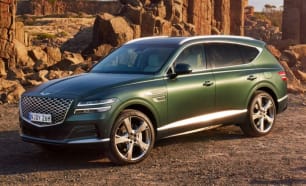At $109,500, before on-road costs, the base GV80 3.5T plays in the same luxury SUV sandpit as BMW’s X5 xDrive25d ($109,900) and the Lexus RX 350 Sports Luxury ($109,800).
But our test example featured a couple of tasty options in the form of the ‘6-Seat Luxury Package’ ($13,500) and ‘Matte Paint’ in Brunswick Green ($2000), for an as-tested MLP of $125,000.
That kicks it up into the same territory as the BMW X5 xDrive40i ($130,900), Lexus RX 500h ($126,000) and Mercedes-Benz GLE 450 ($135,200).
As you might expect, the GV80 3.5T is loaded with standard features that help it match, and at times exceed, the competition. Prepare yourself.
Aside from the safety and performance tech covered separately in this review, it includes, three-zone climate control, leather trim on the seats (partial), dash, doors and centre console, active cruise control (with stop-go function), ‘Surround View Monitor’ (360-degree 3D view, reverse view, parking distance warning, and more), a 14.4-inch multimedia touchscreen, 21-speaker ‘Lexicon by Harman’ audio (with 1050W 14 channel amp and digital radio) and 12-way power-adjustable (heated and ventilated) front seats (with two memory positions on the driver’s side).
Then you can add wireless phone charging, a panorama glass sunroof, a hands-free power tailgate (height and speed adjustable), 8.0-inch configurable digital instrument display, a 12.0-inch multi-function colour head-up display, genuine open pore wood trim on the doors and front centre console, LED headlights (auto-levelling), LED daytime running lights and tail-lights, 64-colour ambient interior lighting, and 22-inch alloy rims. Phew!
You’d think there wouldn’t be room for anything else, but where there’s a will there’s a way, and our test car’s 6-Seat Luxury Package adds even more swag.
How about ‘Remote Smart Parking Assist’, 18-way power fronts seats (with all kinds of additional electronic adjustments), power-adjustable second and third-row seats, a bigger 12.3-inch instrument display, dual 9.2-inch HD media touchscreens for back seaters, heated and ventilated second row seats, a heated steering wheel, Nappa leather trim, suede headlining, and the open pore wood trim is extended to the second row centre console. This is getting ridiculous…
If you want to go down to the next level of detail there’s even more standard kit, but you get the idea. This is a genuinely luxurious SUV with an amazing amount of included features for the money.
The Genesis official fuel economy number for the combined (ADR 81/02 - urban, extra-urban) cycle is 11.7L/100km, the twin-turbo V6 emitting 273g/km of CO2 in the process.
Over a week of city, suburban, and some freeway running we averaged 13.3L/100km, which is thirsty, but not outrageous for a 2.2-tonne twin-turbo V6 SUV.
Minimum fuel requirement is 95 RON premium unleaded and you’ll need 80 litres of it to fill the tank.
Using the official number, that translates to a range of around 680km, which drops to just over 600km using our real-world figure.
The Genesis GV80 is covered by a five-year/unlimited kilometre warranty (now the norm in the luxury segment), with paint application defects (overspray, runs, mismatch, etc) covered for 12 months/unlimited km.
You can also factor in 10-year, 24/7 roadside assistance and complimentary nav map updates for the same period.
Then, under the umbrella of ‘Genesis Service Concierge’ you’ll receive five years complimentary servicing with the choice of a valet pick-up and return, or a courtesy vehicle. Nice.

